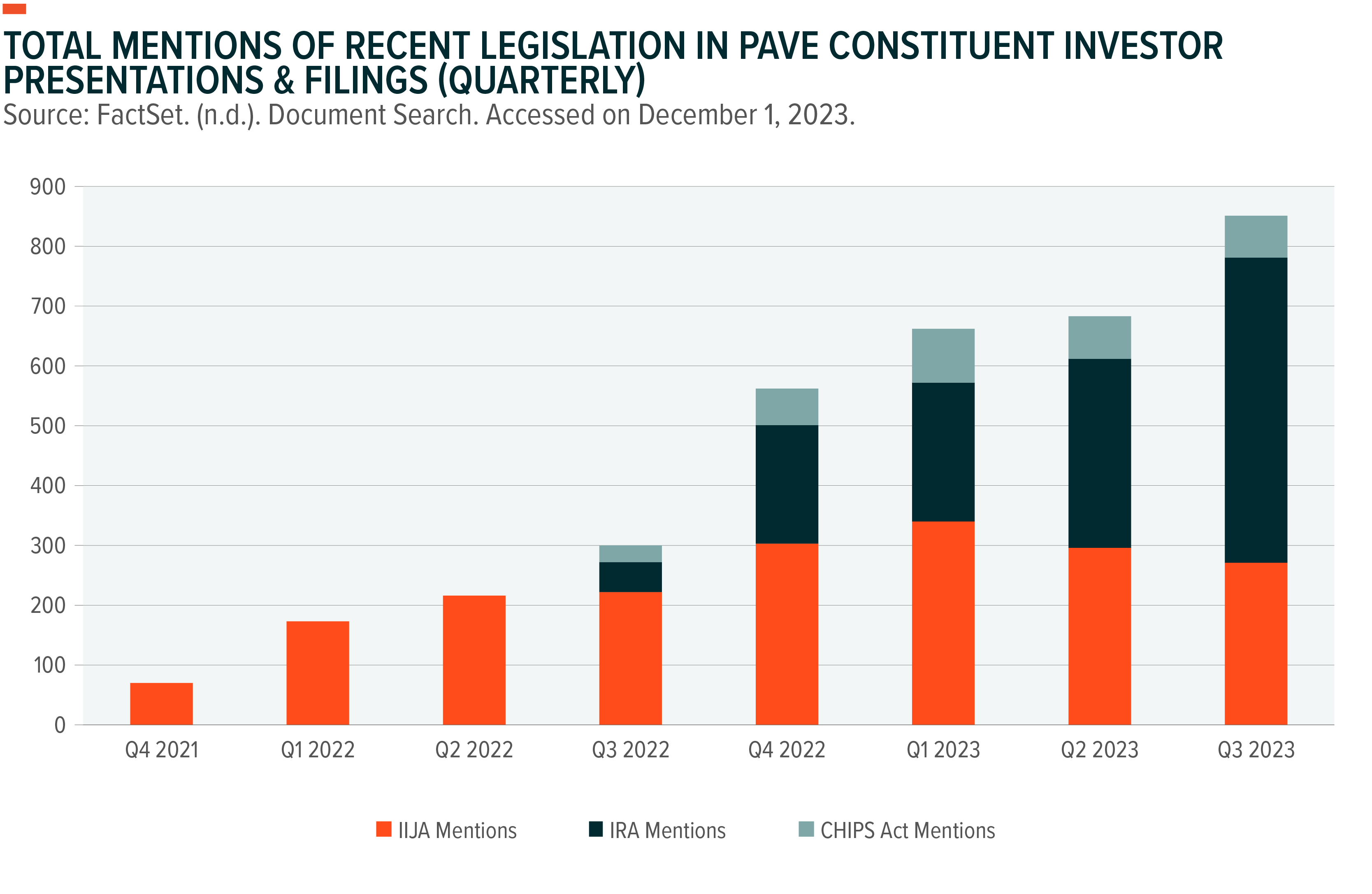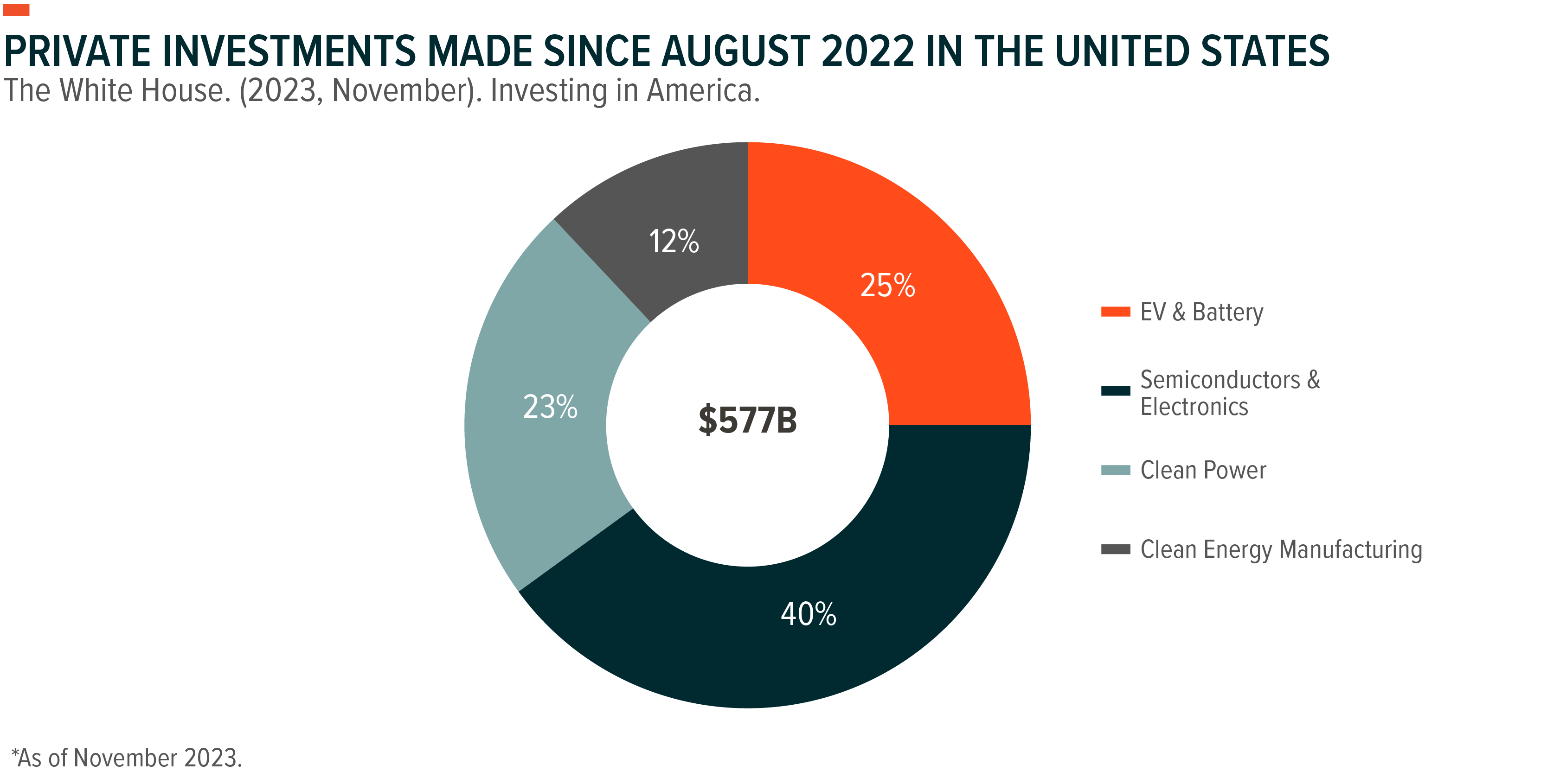Benefits of Infrastructure-Aligned Bills Begin to Converge
Guidance from U.S. infrastructure companies continues to point to 2024 as the beginning of potentially powerful overlapping effects between the Infrastructure Investment and Jobs Act (IIJA), the Inflation Reduction Act (IRA), and the CHIPS and Science Act. Companies in the infrastructure space have generally reported strong earnings amid difficult operating conditions in recent years, but that performance is mostly attributable to structurally high demand for construction across several key segments. Many of these companies have yet to recognize benefits from the hundreds of billions in federal and private funding that is barreling toward the space. We expect that to change in 2024, creating potential opportunities for investors.
This piece is part of a series that dives deeper into this year’s iteration of our flagship research piece, Charting Disruption.
Key Takeaways
- The IIJA’s impact is evident already, but we expect benefits from the bill to increase as its implementation ramps up.
- Infrastructure development management teams continue to highlight the IIJA along with the IRA and CHIPS Act as potential sources of tailwinds.
- The IRA and CHIPS Act stirred a wave of private spending that is likely to magnify the effects of federal spending.
IIJA Rollout Continues, with Most Benefits Still to Come
In early November 2023, the Biden Administration provided an update on the IIJA to mark the two-year anniversary of the bill’s passage. The administration reported that $400 billion for more than 40,000 projects at the state level has been announced.1 This tally does not represent “shovel-ready” projects, as many projects remain in their planning stages with several more steps needed before construction can begin. Announced projects are likely an indication of where federally funded construction could occur. We expect the total thus far to represent only a subset of what is to come from the IIJA.
Still, many projects are moving forward already thanks to the bill. Thus far, the IIJA helped launch 7,800 bridge repair projects, jumpstart renovation on 135,800 miles of roads, and fund 190 airport modernization efforts.2
On recent earnings calls, infrastructure development management teams highlighted the benefits coming from the IIJA. During engineering services company Jacobs Solutions’ fiscal Q4 2023 earnings call, management said that its IIJA-related transportation project pipeline grew 20% year-over-year.3 Also in the engineering space, Tetra Tech noted on its fiscal Q4 2023 earnings call that a large portion of added government project backlogs during the quarter were IIJA-related.4 Management also said that they expect additional revenues attributable to the IIJA to peak in late 2025 or early 2026.5
Infrastructure Is Drawing Attention and Dollars from the Private Sector
Along with the IIJA, the IRA and CHIPS Act are increasingly topics of conversation on earnings calls. The IRA and CHIPS Act provide various incentives to manufacture clean tech and semiconductors in the United States, which could present direct opportunities to domestic companies with the expertise to build out industrial capacity.

The IRA builds on provisions in the IIJA to support increased renewable energy generation, expand transmission capacity, and further electric vehicle (EV) adoption and charging network deployment. In our view, investments in these segments can directly and indirectly boost demand for construction services and equipment. For example, according to the Department of Energy, total transmission infrastructure capacity in the contiguous United States is expected to grow 57% between 2020 and 2035 due to support from the IRA and IIJA.6 This forecast compares to just 16% growth in a baseline scenario where neither bill was passed.
Federal spending is also encouraging the private sector to act. Since the CHIPS Act and IRA passed in August 2022, private funding for areas like semiconductors, clean power and equipment, and EVs and batteries totaled $577 billion as of November 2023.7 In this sense, the enormous topline numbers for these bills actually understate the magnitude of funding that could impact the U.S. infrastructure space over the next several years.
Conclusion: Momentum Builds Around U.S. Infrastructure
The IIJA represents one of the most direct and substantial investments toward U.S. infrastructure in history. Also primed to stimulate the construction value chain are the IRA and CHIPS Act, particularly from the energy transition perspective. These historic investments remain in their early days in terms of impact, but they are already working together to drive positive sentiment toward the U.S. Infrastructure Development theme heading into 2024.


